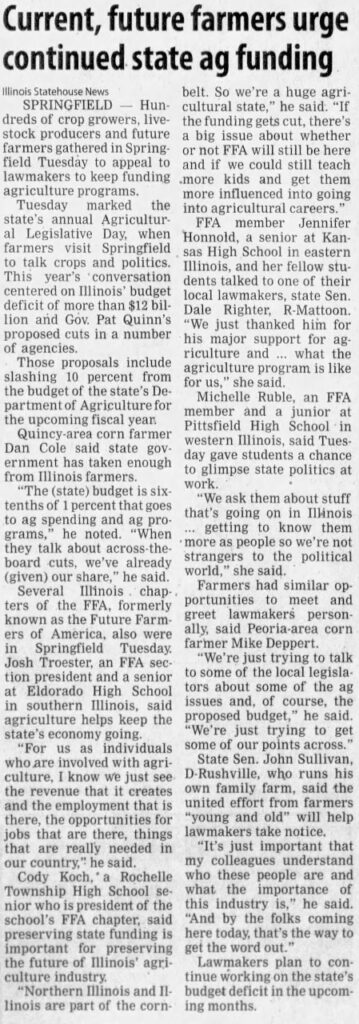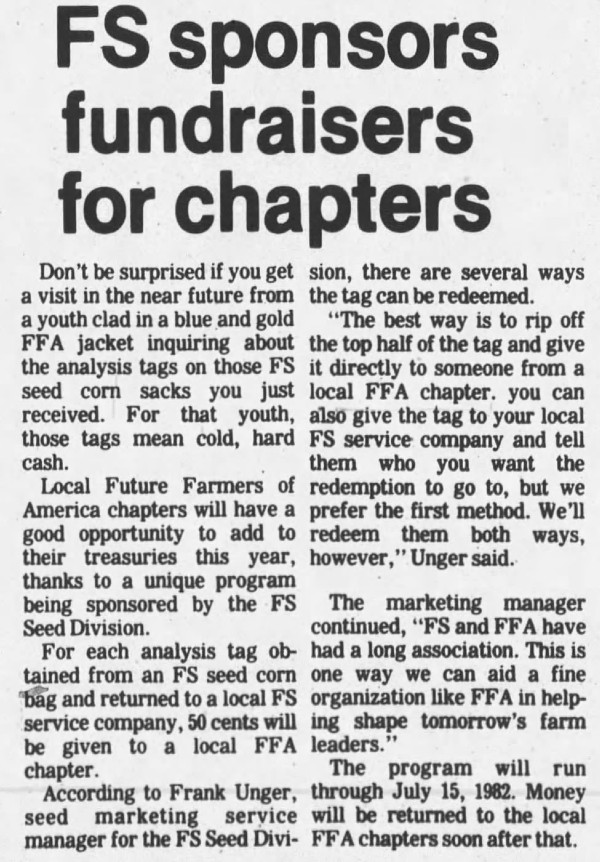This week we wrap our exploration of agricultural education in Illinois. Illinois was the 21st state to receive a charter from the National FFA. That was in 1929. To see the charter application follow this link. According to the Illinois FFA website there are 372 agriculture programs in Illinois with 42,217 FFA members. The state website for Illinois Agricultural Education and FFA is https://www.ilaged.org/.
The common theme that emerged as I researched this Footnote was money.
You’ve Got a Friend in Me – Culver’s
In the animated movie Toy Story the theme song is “You’ve Got a Friend in Me.” For the Bureau Valley FFA in Manlius, Illinois that friend was Culver’s Restaurants. The Culver’s in Princeton donated more than $2,000 to the FFA in 2023. The FFA planned to start a pollinator plot with the money. See Figure 1 for more information. To learn more about Culver’s FFA support program go to this link.

Figure 1. The Bureau County Republican (Princeton), March 8, 2023.
Payment is Optional!
A Purina sign in my high school agriculture classroom stated, “A Good Idea Doesn’t Care Who Has It.” When I found the 2021 article about the Seneca FFA and their pork chop dinner fundraiser, my reaction was “Wow! What a great idea.” Instead of charging $10 for the pork chop meal the payment was optional. The 480 dinners they sold brought in $6,600. This is something more FFA chapters who have meal fundraisers should consider. Because of the generosity of the patrons the FFA was able to donate $2,250 to two local food banks. See Figure 2 for details.

Figure 2. The Times. Streator, IL, March 11, 2021.
The Message is Clear – Continue Funding Agriculture
When there is a state budget deficit of twelve billion dollars, what should be cut? The governor of Illinois proposed a ten percent cut for the state’s Department of Agriculture in 2010. In response to the proposed cuts, farmers and FFA members went to the state capital to meet with legislators. The 700+ FFA members met with their state representatives and thanked them for their support and urged them to continue their support. If your state FFA does not have a legislative day at the state capital, this is something to consider. It could be beneficial to agricultural education. See Figure 3.

Figure 3. The Rock Island Argus, March 17, 2010.
What is a Seed Corn analysis Tag worth?
Over the years I have seen numerous fundraisers for FFA chapters but I discovered a new one in preparing this Footnote. In 1982 the FS Seed Division (FS is a farm cooperative operating in 40 states and Ontario, Canada) was paying fifty cents for each seed analysis tag from a FS seed corn bag returned to the local branch. FFA members could collect the tags or farmers could turn them in to the local cooperative with instructions that the bounty go to the FFA. See Figure 4.

Figure 4. Daily Republican-Register (Mt. Carmel, IL) February 24, 1982.
How About a Loan?
An article in the Freeport Journal-Standard in 1959 announced that the Dakota FFA chapter had started a Cooperative Credit Association. Surplus funds in the chapter treasury were used to start the program. The Association planned to loan money at low interest rates to FFA members so they could expand their farming programs. See Figure 5.

Figure 5. Freeport (IL) Journal-Standard, February 20, 1959.
Is Vocational Agriculture Worth It?
In the early days of agricultural education the leaders often made the case that, from a financial standpoint, money spent on vocational education had a good rate of return on the investment. The headlines on an article published in 1924 in The Dispatch of Moline, Illinois revealed that “Farm Education Pays Dividends.” See Figure 6.

Figure 6. The Dispatch, Moline, Illinois, July 24, 1924
Concluding Remarks
The newspaper clippings used in the Footnote spanned a time period of nearly 100 years in Illinois – 1924 to 2023. We have learned that agricultural education is a good investment for the government and community. State and community support is important for agricultural education. We must continue to deliver that message. And in return the FFA supports the community in a variety of ways and develops future agricultural leaders. This is a perfect example of a symbiotic relationship.
